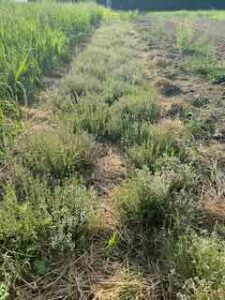Progress report for FNE24-076
Project Information
This project will explore whether availability of thyme pollen and nectar has a positive impact on bee health. Varroa mites and the lethal viruses they
transmit continue to present a huge challenge for northeastern beekeepers, with Vermont beekeepers losing 30-80% of their overwintered colonies annually over the last decade, mostly to mite pressure. Mite disease have a huge economic impact on beekeepers, both in colony losses and in expenditures for mite treatments, which are often applied multiple times in over the course of a season.
We propose to compare nosema, varroa mite and virus loads in colonies with and without access to thyme flowers planted on a diversified organic vegetable farm. Thymol, a terpenoid which is present in thyme nectar and pollen, is also the active ingredient (at much higher concentrations) in
Apiguard and other commonly used in-hive varroa mite treatments. Research indicates that chemicals in plant nectar and pollen can improve honeybee viral immunity, and that honeybees can preferentially self-medicate by choosing honeys with higher antibacterial activity. Research at UMass Amherst has shown that increased sunflower pollen availability on a landscape level correlates with significantly reduced varroa mite levels in
honeybee colonies.
The anti-pathogenic activity of thyme is well-documented, and we are curious whether planting thyme on our farm can support the health of our honeybee colonies - and if the bees will visit the flowers, and collect the pollen and nectar. We will also sample neighboring bumblebees and test
their virus loads.
This project takes up a question I’ve been curious about as a farmer/beekeeper for years: can pollinator health and productivity be augmented with herb plantings on farms? We will test whether thyme nectar and pollen can positively impact honeybee health and productivity, with a focus on varroa mites and related viruses, by comparing colony health in locations with and without thyme plantings. This work builds on other studies exploring how anti-pathogenic plant compounds interact with bee health. In order to assess thyme impact on honeybee health, we will collect data including nosema
(a spore-forming fungus) and varroa mite counts, varroa-related virus levels, and colony productivity and winter survival. Nectar and pollen will be sampled during bloom and analyzed to confirm that the bees are foraging on thyme. A few secondary objectives will also be addressed, including gaining understanding of how many plants are required to have an impact on bee health, monitoring levels of honeybee viruses in bumblebees (an issue of state and nationwide concern), and developing a low-cost, easy to install and maintain method for interested beekeepers to establish flowering thyme and other herbs in beeyards in 6” pots. We will also learn about floral diversity at study locations.
Honeybees are critical components of our agricultural systems, and are one of the most important pollinators of both wild and agricultural plants, making them essential for ecosystem health and food security (Campolo et al 2016). Over 80% of the world’s flowering plants require a pollinator to reproduce, and ⅓ of our food is the product of pollination, with honey bees a primary pollinator across agricultural systems.
Beekeepers in Vermont and across the country face significant and ongoing challenges as annual hive losses continue to rise. The average annual loss rate amongst commercial beekeepers over the past 12 years is 40% (Bee Informed Partnership, 2023), with losses around or above 50% twice in the past five years (51%, 2020-21; 48% 2022-23). Vermont has been hit especially hard, especially of late; Vermont beekeepers reported losses of 71% in 2021-2022, and 85% in 2020-21 (Bee Informed Partnership, 2023). There are multiple synergistic stressors of honey bees, including habitat loss and decline of forage diversity and abundance, prolonged sub-lethal pesticide exposure, increased erratic weather from climate change, and pest and pathogen pressure. Beekeepers attributed their losses primarily to varroa mites and queenlessness.
Primary amongst the direct causes of colony death are varroa mites, along with the suite of viruses they transmit to honeybees. Tackling mites presents a significant cost to northeastern beekeepers in mite treatments as well as colony losses and lost productivity. To reduce mite counts, beekeepers treat their colonies with a variety of acaricides, as well as utilizing mechanical approaches like drone brood removal and screened bottom boards. Off the shelf acaricides - often the only legal way to treat colonies for mites - are prohibitively expensive, costing $5-$10 per hive treatment, and beekeepers often must apply multiple treatments each year to maintain control. While mitigating mite loads, these treatments can have a variety of impacts on bees, especially over time, including reduced queen productivity and longevity (Rangel, Apimondia 23) (and, sometimes, death at the time of application) and effects on memory and sensory processes (Bonnafe, Elsa et al 2015). Many of these treatments are mildly toxic to humans as well, and require protection during application.
This project will investigate the potential for perennial plantings of medicinal herbs, many of which contain highly active anti-pathogenic compounds, to provide forage for bees and improve hive health. Thyme nectar and pollen, for example, contain thymol, a terpene which is also the active ingredient (at much higher concentrations) in commonly used over-the-counter in-hive varroa mite treatments, extracted from thyme plants and formulated for sale in vapor-release products like Apiguard and ApiLife Var.
Thyme itself is a well-known honey plant, producing a characteristic aromatic honey with herbal flavors. Greece in particular is known for its thyme-covered hillsides and thyme honey. Of note, a recent 4 year review of winter colony losses revealed that colony losses dropped significantly in 2020 and 2021 (average losses in 2018: 22.3% and 2019: 24%, in 2020: 14.4% and 2021: 15.3%) as Greek beekeepers transitioned to rely more heavily on organic mite control methods, and increased their use of natural landscapes for colony locations, with increased access to forage like thyme, citrus and pines.
If foraged thyme has an impact on bee health, it could be a critical tool in the fight against varroa mites, help mitigate the severe economic toll varroa has on beekeepers, and promote pollinator health.
Cooperators
- - Technical Advisor
- (Researcher)
Research
This project is underway in the Nashville valley along Nashville Rd in Jericho-Bolton, VT, with two bee yard locations at either end of the valley, about 3 miles apart. One location - at Bone Mountain Farm - is planted with thyme, and the other location (“Chocolate Pond”, on Fields Ln) is not.
In early April 2024, we seeded thyme in open trays in the greenhouse, and I treated the beehives with Apivar (amitraz, 2 strips).
In May 2024, I moved 8 beehives from a bee yard in Jonesville, VT to Fields Lane, establishing the control bee yard. Later that month, along with the VT Bee Lab, we labeled and numbered the project bee hives with bright duct tape and collected our first samples of 300 bees from each hive to test for virus loads and mite and nosema counts. The mite samples were preserved in alcohol, and the virus samples on dry ice.
I continued collecting samples from each bee hive for mite and nosema testing monthly during the last week of the month, through August, which were processed by the VT Bee Lab.
On May 30, 2024, we transplanted the thyme into a 200’ bed at Bone Mountain Farm, next to a 100’ planting of thyme established in spring 2023, which had successfully overwintered. It was very dry at that time, and we had to water the new transplants twice that week, which accomplished from a water tank on the tractor with a hose. 25 plants were transferred into 6” pots.
By late May 2024, the 2023 thyme was blooming, and continued to do so throughout most of the month of June. I performed weekly pollinator counts, estimating % cover of flowering thyme in the bed and counting the honey bees and other pollinators as I walked (in a hunched over sort of way) the bed for 5 minutes. The pollen traps at both Bone Mountain and Chocolate pond were opened periodically during the thyme bloom to collect pollen samples.
In July, the bees were treated with Formic Pro according to instructions (2 pads per beehive).
In late August, the bees were again treated with Apiguard (thymol, 1 tray per beehive).
I was unable to collect virus or mite samples in September as planned, as the Chocolate Pond bee yard was attacked by bears, destroying all of the beehives. The pollen samples collected earlier in the summer were also not processed.
This season was replete with challenges.
Mite pressure was very high across the state this year, including in my apiary. My spring Apivar treatment was not effective, indicated by the results from the May mite counts. Most of the hives were well above treatment threshold (2%), and some had extremely high mite loads. I did not receive the results for the May counts until July, and based on the results treated the hives immediately with Formic Pro.
Additionally, the hives I moved from Jonesville were in a location with significantly more mite pressure from surrounding commercial beekeepers than my isolated yards in Nashville, revealed when I got the first set of mite counts. Consequently the hives in the Chocolate Pond control yard had higher initial mite counts, compromising the comparative experiment. Ideally, the hives in the two experimental locations would have been equally distributed when I set up the yards - eg, 3 hives each from the Bone Mountain and Jonesville yards, and 2 from Mike Palmer (total 8 each yard), but I was unable to because of the logistics of securing help to shuffle and move all of the beehives.
The 2023 thyme planting bloomed in early June, a month earlier than I had anticipated based on previous plantings, and continued to bloom through the month of June, winding down during the fourth week. As a note, June is a period of intense blooms, with bees visiting a diverse variety of flowers. Small flies and beetles dominated the pollinator counts, with over 30 of each counted weekly, and honey bees were also present in significant numbers (20-25), as well as an occasional native bee (2-3).
Pollen traps were opened on the hives during this time, although because of ensuing events during the season, these samples have not been processed.
In July, Bone Mountain Farm was severely impacted by flash flooding in the Nashville valley, and the river - which had curved just above the farm fields - cut a new channel, which now runs through the farm fields (and the bee yard). A student from the UVM Beekeeping class volunteered to help clean the mud from the bottom boards of the flooded hives, and replace them on taller hive stands to avoid the impacts of future floods.
On top of the near total crop losses, Bone Mountain lost many tons of topsoil, and river rocks, sand, and flood debris were deposited in the fields. Bone Mountain is working with neighbors, the state of Vermont, and federal agencies to address the damage, and it is unlikely that the farm fields will be restored to agriculture. My bees are currently in the same location - a somewhat higher spot in a copse of birches - on the farm, and are accessible - except when the combination of saturated soils and rain sets the new river channel running through the farm fields again. I am uncertain whether Bone Mountain will continue to be a viable location for my bees.
The availability of Bone Mountain employees to help with the thyme bed maintenance (weeding, mowing) was limited because of the flood impacts on the farm. Additionally, the thyme was planted on an area of the farm with significant weed pressure, and weekly attention was required to keep the weeds under control. We were hesitant to mulch, as the beds continued to flood during rain events throughout the rest of the summer.
Because of the flood impacts, as well as the small sample size of this project and the many variables in the field, the VT Bee Lab recommended considering a new approach: raising baby bees in the laboratory and infecting an experimental group with mite viruses, and feeding both the control and experimental group thyme pollen to determine any impact on virus loads.
We explored alternate locations with wild thyme present in order to collect thyme pollen in late July - at that point, I was unsure whether the thyme planted at Bone Mountain would survive the flooding - and made contact with the Camp Ingalls Natural Area on South Hero island, where wild thyme blooms in profusion in July and August. They were open to placing beehives there while summer camps were not in session. We did not end up placing beehives there this year (2024), but Camp Ingalls is open to the idea in the future.
We also considered collecting buckwheat pollen - buckwheat is commonly planted on farms as a cover crop, and research indicates that buckwheat has medicinal properties and compounds as well. UVM Extension was running a project in 2024, investigating the impacts of flowering cover crops on soil health, and counting pollinators while the cover crop was flowering. Bone Mountain was among the farms participating in this project, although our buckwheat and phacelia plantings were destroyed by the flood. The UVM Hort Farm was another participant, with a stand of blooming buckwheat at the end of July, and in early August I moved a few beehives there in the event we decided to transition to a lab-based project.
One consideration with both buckwheat and thyme is that they have very small flowers, and while copious nectar producers, it is unclear how much pollen bees collect from these plants. I did not observe honeybees carrying pollen on either of these plants.
September was very warm, and along with all the water in the ground produced a copious goldenrod flow for the bees. Bear activity in my neighborhood was very high, with neighbors reporting bears in their yards and garbage. Over a week in early-mid September, the Chocolate Pond (control) bee yard was attacked by bears - there must have been an initial electric fencing failure. Despite addressing the fence failure and bolstering the fencing, the bears continued to return and destroyed all of the beehives in that yard, a heavy loss. This yard also included the nucleus colonies intended for use in 2025 and 2026. I’ve been in touch with the game warden about the bear issue.
The 2024 thyme planting survived the flood, and started to bloom (but did not reach full bloom) in September. Because of the bear issue, I did not complete the pollinator counts or the September virus/mite counts.
By the end of September, three of the hives at Bone Mountain had succumbed to mites and died; two were weak, and I united them, leaving only 4 program beehives at the end of the season.
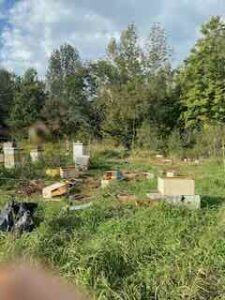
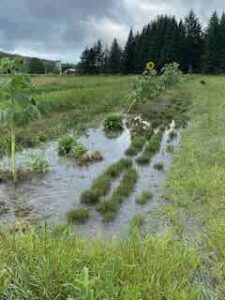
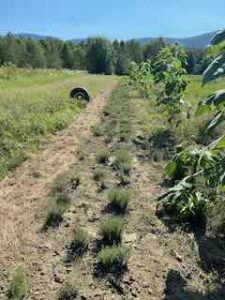
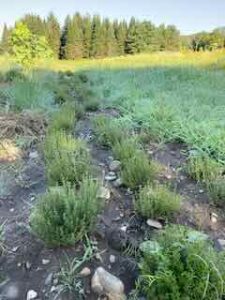
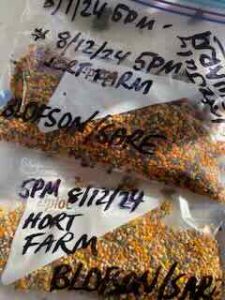
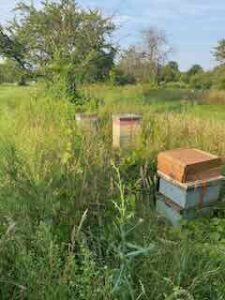
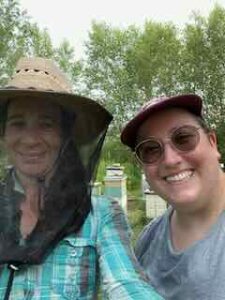
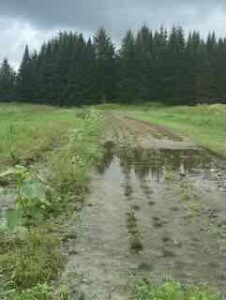
Thyme post flood with Morgen 7/12/24
Bone Mountain bee yard access flooding 7:11:24
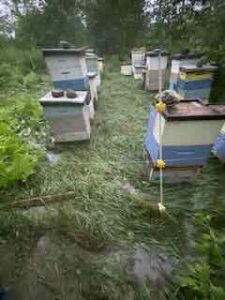
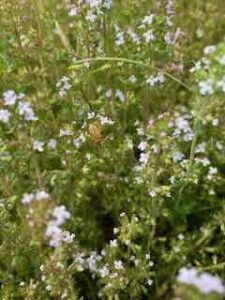
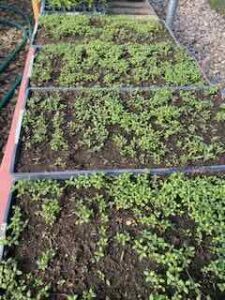
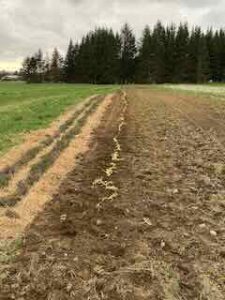
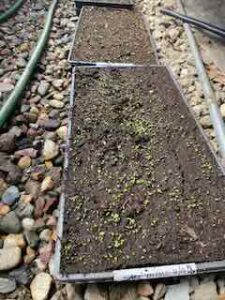
Education & Outreach Activities and Participation Summary
Participation Summary:
Two member of UVM's beekeeping class joined me at the end of June to observe and assist with mite counts. One of these students returned in July to assist with flood recovery in the Bone Mountain bee yard.
